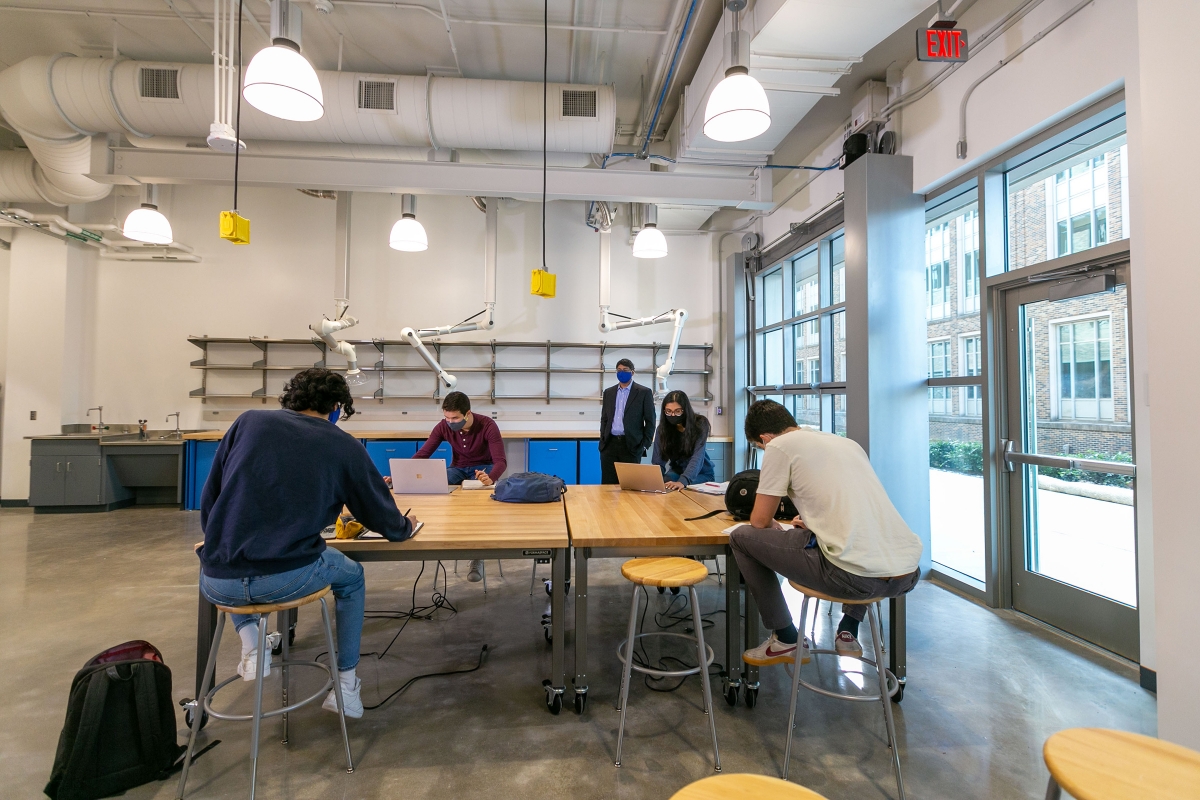Christensen Family Center Is Home to a New View on Innovation
Mark Schreiner
The new Duke Engineering center seeks to not only develop student innovators, but discover how to make innovation easier, faster, cheaper

When people ask Executive-in-Residence Steven McClelland about the vision for the Christensen Family Center for Innovation at Duke, he quotes Proust: ”The real voyage of discovery consists not in seeking new landscapes, but in having new eyes.”
A Commitment to Duke
The center’s name honors a major gift from the family of Clayton Christensen, the management thinker who coined ‘disruptive innovation’
For years, McClelland and his Duke Engineering Entrepreneurship (EngEn) colleagues have mentored individual students and teams in their search for real-world needs and designing novel and effective solutions for them.
In the Christensen Family Center, McClelland and other leaders will take that one step further by looking at the whole process of innovation with fresh eyes. The goal: to make the difficult, circuitous, and often lonely process faster, cheaper, and easier to learn.
To start, the center will:
- Serve as a home and community for people who want to practice turning their ideas into impact
- Enable innovation through the application of digital technology
- Support teaching of innovation by identifying best practices
“As we launch, we’re seeking two things,” said co-leader Donna Crenshaw, who is also executive director of the MEDx initiative between Duke’s School of Medicine and the Pratt School of Engineering. “To create a home for a community of people, from different disciplines and backgrounds, who use or want to learn design principles to develop implementable solutions to authentic problems, and stakeholders, from the university, the community, and industry, who bring the real-world problems that we can work on.”
A home and community for innovators
The Christensen Family Center for Innovation is on the first floor of the new Wilkinson Building. It includes a maker space “garage lab,” and meeting and office space.
It is home to Duke Design Health and will be home to future cross-disciplinary innovation programs in climate and defense. An overriding principle for every initiative that the center undertakes is that processes and solutions incorporate diverse viewpoints and experiences. The center has also become a partner with the Duke Open Design Studio, which incorporates into its human-centered design process elements such as empathy, an individual’s responsibility to others, inclusivity, and transparency to the design process.
Crenshaw and McClelland said the center’s community includes all of Duke, Durham and North Carolina.
“The Christensen Family Center for Innovation is open for business. We’re building a community of people who are teaching and practicing the skills needed to solve complex problems.”
Donna Crenshaw | Executive Director, Duke MEDx
“We’re open for business,” Crenshaw said. “Anyone interested in innovation is invited to visit us in the Wilkinson Building and to reach out to us. We want to build a community of people who are teaching and practicing the skills needed to solve complex problems.”
To support that community, the Christensen Center will offer an initial set of digital solutions for innovators. These are intended to help speed the innovation process. But they will also gather details on how the process worked or didn’t work in individual projects.
Enabling innovation through digital technology
“Information technology has been proven to create efficiencies in every industry where it has been deployed—it makes cycles of improvement faster and the data it collects provide insights and new perspectives,” McClelland said.

Yet, he said, the common practice of the innovator can be to work in isolation, not knowing if another person in the community is working on a similar problem. Or, knowledge gained during the life of a project, over a semester or a few years, maybe lost as team members move on to other things.
“Designers graduate,” Crenshaw said. “People move on. Our vision is to use digital technology to make sure that nothing learned is lost, and that what is learned can be shared.”
The center is working on a digital tool that can store and analyze all the information gathered as part of an innovation effort. For example, suppose a team observed work at Duke University Medical Center looking at a problem with clinical scheduling. In that case, they can use the tool to upload the notes they’ve taken, transcripts of interviews with clinicians and patients, even upload videos documenting the problem they’re trying to solve. The tool digitizes all the information and then analyzes it, looking for patterns and valuable insights. The tool’s knowledge base and ability to synthesize insights grow as more innovators contribute.

Another tool, which has been used to help scale the Student Founder Program, helps manage and track the process of participants interested in startups. Simple digital tools help to facilitate communication, coaching, and the progress of participants’ ideas. Using a system and analyzing the data helps to improve the program and more efficiently direct resources where they can be most helpful.
With a community in place and data flowing in, McClelland and Crenshaw foresee new insights emerging on improving the process of innovation.
Support the teaching of innovation by identifying best practices
“It’s always better when you know how to get good results. We know in other fields, medicine for example, that evidence-based frameworks and best practices work,” Crenshaw said. “But, unlike medicine, innovation isn’t a very observable practice. Even the inventor might not realize precisely when or why they had their ‘lightbulb moment.’ “
McClelland and Crenshaw plan to share what they learn about those potential best practices as widely as they can. And they expect and want feedback and debate on the insights the center develops.
“We’re motivated as engineers, as people who want to solve problems, and we’re also motivated by the vision presented to us by our namesake, the Christensen Family,” McClelland said. “They gave us a sense of urgency — get out there, help people, make an impact, be a catalyst for action. Engineers aren’t just mechanics; they’re leaders who drive solutions to improve society. We bring new eyes.”
More about Entrepreneurship at Duke Engineering »
